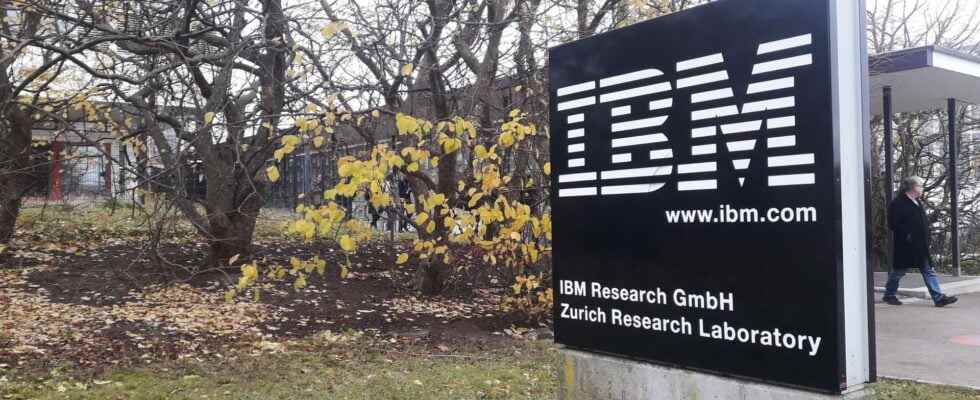Known rather for being one of the world capitals for the banking and financial sectors, Zurich is home to one of IBM’s 12 research centers, in which the synergy between cloud, artificial intelligence and quantum computing shapes the contours of new technologies of tomorrow.
IBM opens the doors from the future. Exceptionally accessible for a press visit, the Zurich research center unveiled some of the innovations that will shape the IT of tomorrow. History speaks for itself, as it has hosted no less than four Nobel laureates from physical : Gerd Binnig and Heinrich Rohrer in 1986 for the invention of the scanning tunneling microscope, followed a year later by Georg Bednorz and Alex Müller for the discovery of the superconductivity at high temperature. Created in 1956, it houses 3,000 permanent researchers from 45 countries, with quite varied cutting-edge specialties: computer scientists, biologists, chemists … ” Here is preparing the future of computer technologies with a synergy between cloud, artificial intelligence and quantum computing », Rejoices Alessandro Curioni, director of the center.
Optical and quantum computing
Among the research subjects, optical computing for example, that we discover at the bend of one of the many long corridors which give a mysterious aspect to this laboratory of the future. To replace electricity with light, here are tested “supercrystals” assembled from a new class of materials optoelectronics, the nanocrystals of perovskite, which could lead to the development of new photonic materials and structures, 100 times faster and 100 times less energy intensive than current transistors. But the undisputed star of the laboratory is the famous quantum computer which is revealed to our eyes, well in any case a part, that which allows to maintain the processor superconductor at a temperature close to absolute zero (-273.15 ° C).
Quantum computing, from dream to reality
According to Alessandro Curioni of quantum computing, “ what was still dreamlike four or five years ago is now coming to fruition with roadmaps, application layers and benefits in a growing number of industries “. IBM hit the headlines barely a month ago with Eagle, the 127 qubit quantum processor, the first to pass the mythical bar of 100. The number of qubits is one of the three elements that qualifies quantum power. The other two are quality, represented by the volume quantum, and speed treatment determined by a new unit of measurement: the CLOPS (Circuit Layer Operations per Second). Thanks to all this, a quantum computer promises to perform in a few minutes calculations that would currently take up to hundreds of years …
Is the world ready for quantum computing?
This is the whole issue of quantum computing: solving complex problems or dealing with masses colossal data thanks to multiplied computing capacities. ” But is the world ready for this? », Asks Heike Riel, Quantum Lead Europe and Africa for IBM. If research is progressing rapidly, it is therefore also a question of thinking about the future regulations necessary around this emerging technology, but also of developing collaborations to observe the risks and opportunities, therefore making the right decisions when the technology is available. available, multiply the tests so that the borders of the imagination open up with these new capacities.
Synthesize molecules remotely with RoboRXN
For example, from ” new quantum algorithms that we have developed could allow an analysis of the risks of investment portfolios in near real time. Today, such analyzes can take several hours to complete, so that an immediate reaction to changing circumstances is impossible. », Explains Stefan Woerner, head of research and software for the applications quantum at IBM. Another major innovation conceived between its walls : the RoboRXN system which combines artificial intelligence, cloud and automation to revolutionize R&D in the discovery of new materials. Associated with the software developed in open source Qiskit for the chemistry, it allows to remotely synthesize new molecules, to design a chemical procedure that a laboratory robot can perform, all remotely!
The revival of magnetic tape storage
All of this will produce data, even more than now. According to Mark Lantz, Cloud manager FPGA and tape technologies for IBM, ” due to the continued growth ofInternet of things, of the’emergence high-definition videos and AI-powered big data analytics, global data is expected to reach 175 zettabytes by 2025, representing growth annual by 61% “. IBM is working on this on the magnetic tape. Surprising as it may sound, we remember so much the VHS tape that had to be rewound in our memory, but this 60-year-old technology is making a comeback among large-scale cloud companies for data storage because of its low cost, its low consumption ofenergy and its excellent potential for future development. It appears much more credible than alternatives currently being explored such as 3D storage or in theDNA.
Interested in what you just read?
.
fs1
